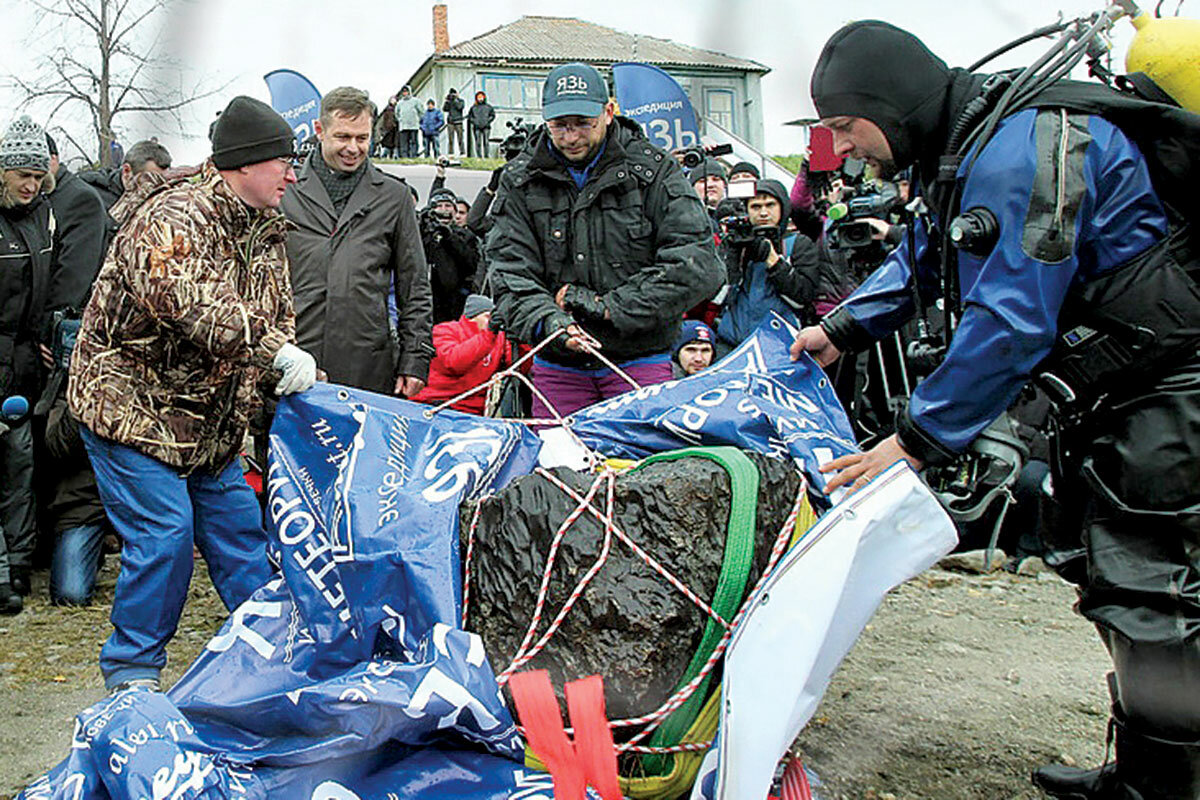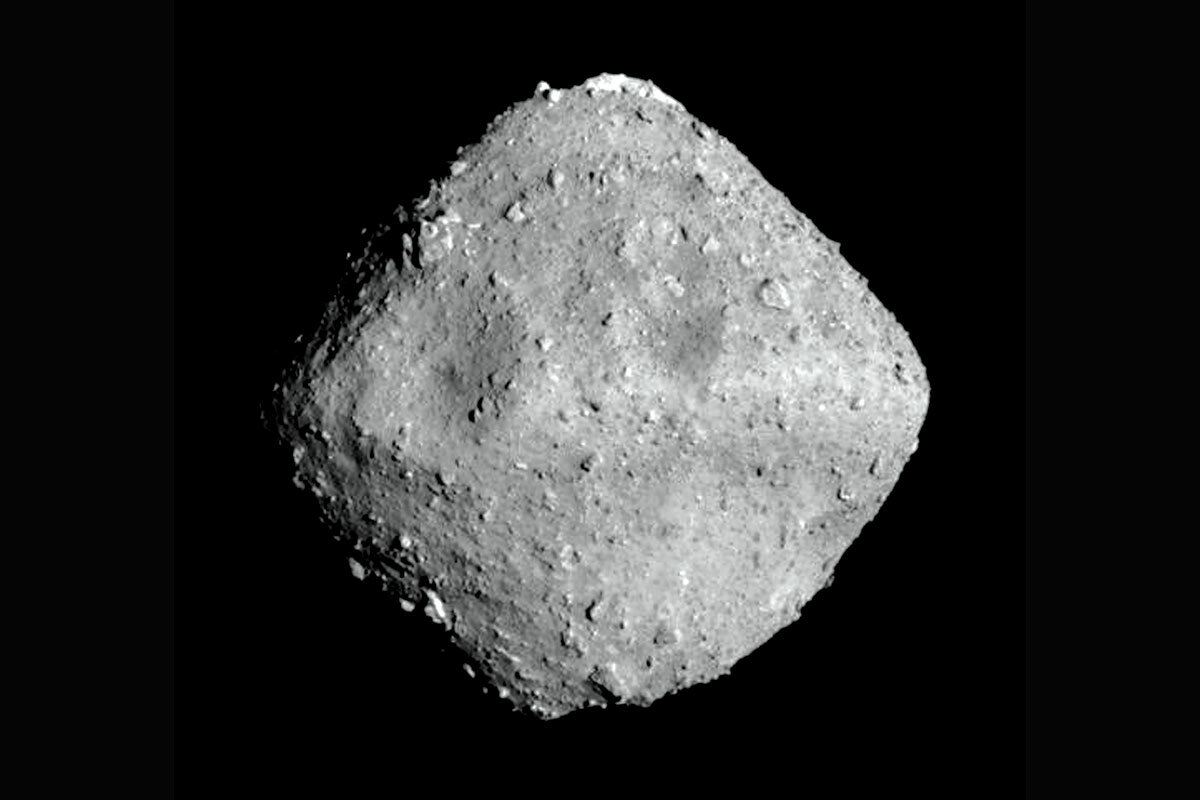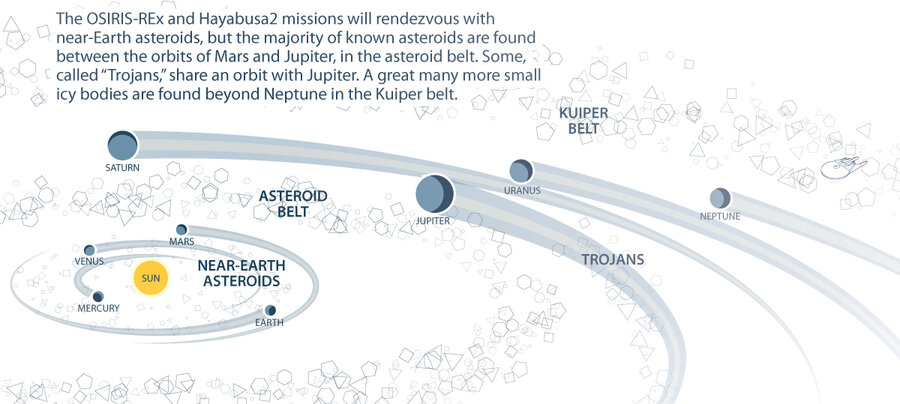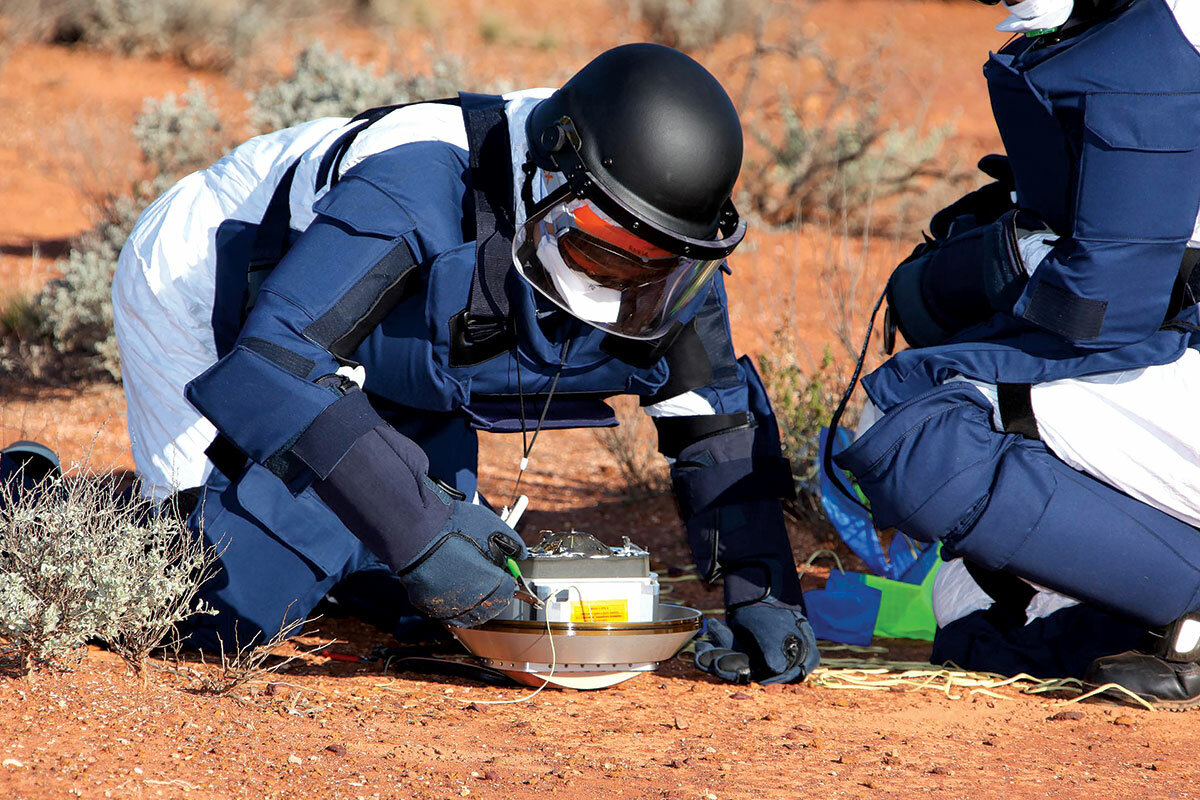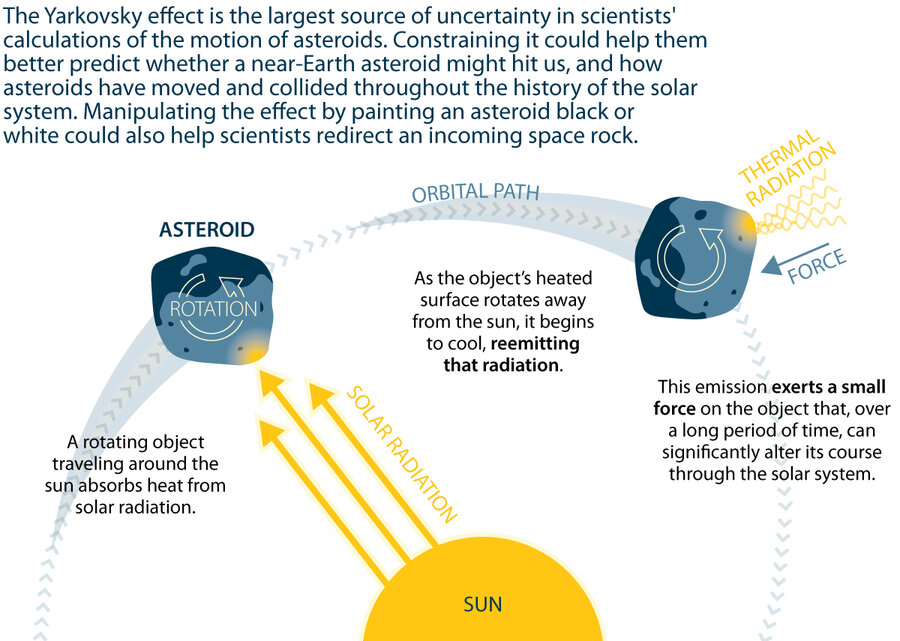Chasing asteroids: Dual missions sniff out clues to solar system's past
Loading...
| BOSTON
It was a normal Friday morning in the industrial city of Chelyabinsk, Russia. Adults were on their way to work, and children were in school. But that ordinary day was about to become extraordinary.
Suddenly, a fireball shot across the clear morning sky leaving a thick trail of smoke, accompanied by the sound of a huge explosion. The shock wave knocked people over, shattered glass, and collapsed a factory roof. As many as 1,200 people were injured. A global network of infrasound sensors designed to pick up nuclear explosions calculated that the boom was 30 to 40 times more powerful than the atomic bomb the United States dropped on Hiroshima, Japan, during World War II.
But this event on Feb. 15, 2013, wasn’t a declaration of war. It was simply an asteroid that crossed paths with Earth on its travels around the sun.
Why We Wrote This
Missions to space offer more than a thrill of exploration, they can expand our understanding of our cosmic place in the universe. This year's twin missions to sample asteroids are no exception.
As the space rock hurtled toward Russia, the pressure of Earth’s atmosphere was too much for it. The asteroid exploded over Chelyabinsk. Much of the material burned up in the atmosphere, creating a spectacular fireball. The remaining chunks fell to Earth, the largest of which plunged through a thick layer of ice into a lake.
The Chelyabinsk meteor stirred up fear in people around the globe. Nobody died this time, but what if a bigger asteroid hits Earth over, say, New York or London? Is humanity in for an asteroid-driven Armageddon?
While this terror periodically grips people around the world – and engages Hollywood screenwriters – it is hardly an imminent threat. True, an asteroid the size of a car plunges toward Earth about once a year, but most of the rock burns up in the atmosphere.
Scientists consider the chance of a wayward asteroid actually doing major damage on Earth quite remote. Instead of doomsday plots, many researchers are far more interested in the space rocks for another reason: the clues they offer to the origins of the solar system.
Because asteroids are the leftover building blocks of planets, their composition may explain how the planets – and the broader galaxy and universe – were formed.
“They’re sort of these time capsules of the early solar system,” says Nancy Chabot, a planetary scientist at the Johns Hopkins University Applied Physics Laboratory. “This is our history that we’re looking at.”
The problem with asteroids is that they’re tricky to study. Most of what scientists know about them comes from afar: They try to match the bits that fall to Earth as meteorites with types of asteroids spotted in telescope data. But that has proved difficult, largely because a lot of material burns off an asteroid as it passes through Earth’s atmosphere.
Now two missions are under way that could yield vital new information about the heavenly objects. Both are robotic envoys settling into position to collect samples directly from asteroids and spirit them back to Earth. A Japanese spacecraft, the Hayabusa2, arrived at asteroid 162173 Ryugu on June 27. The US National Aeronautics and Space Administration (NASA) has a probe set to pull up to asteroid 101955 Bennu in the fall. Both asteroids orbit the sun near Earth’s own path, and Bennu is also characterized as potentially hazardous – one that could collide with our planet.
Many things could go wrong with these daring missions. But if they succeed in carrying pristine pieces of rock back to Earth, these celestial souvenirs could change the way we see asteroids – and ourselves.
“It’s pretty exciting,” says Daniel Glavin, an astrobiologist at NASA’s Goddard Space Flight Center and a co-investigator on the US mission OSIRIS-REx. “You wouldn’t think you could learn so much just from a rock.”
***
Asteroids are space rocks that never became big enough during the birth of the solar system to grow into planets. Some 4.6 billion years ago, there was a wispy cloud of gas and dust in our galaxy that collapsed in on itself, transforming into a flat, spinning disk. In the middle of this swirling mass, material coalesced into what would one day become our sun.
Across the rest of the roiling disk, particles clumped together to form smaller celestial bodies. Just as in a flowing river, eddies formed in the gas and dust, harboring some of the lumps and causing them to concentrate further. Gravity drew them even more tightly together and they condensed into bigger objects: planetesimals, or baby planets. The dust, clumps, pebbles, and planetesimals kept merging, forming larger and larger masses, until eventually some grew into planets.
The planetesimals that never became planets make up the comets and asteroids now whirring around the cosmos. Some of them orbit beyond Neptune in the cold Kuiper belt. Others are collected in a swath between the orbit of Mars and the orbit of Jupiter known as the asteroid belt, with a handful scattered elsewhere.
These space rocks frequently collide with each other. Often they are moving so fast that they shatter on impact, shooting sometimes massive chunks out in all directions, including occasionally toward Earth.
Bits of asteroids that have rained down on Earth have, in effect, offered free samples for scientists to study. And some of those meteorites have already yielded some tantalizing clues as to what might have been present in the early solar system.
The Japanese and American missions will try to build on these previous discoveries – and glean new information altogether. But first, they will have to bring some of the rocks back to Earth, which won’t be easy. Retrieving samples from an asteroid isn’t like picking up pebbles at the beach.
Just ask the Japanese.
***
In 2003, the Japanese Aerospace Exploration Agency (JAXA) embarked on the world’s first attempt to bring back specimens from an asteroid. The mission, dubbed Hayabusa after the Japanese word for “falcon,” would eventually make history. But not before virtually everything that could go wrong did.
The problems began shortly after liftoff on May 9 when a large solar flare damaged the spacecraft’s solar panels. Then, the spacecraft lost two out of three reaction wheels that stabilize the probe as it was getting into position to study its target: near-Earth asteroid 25143 Itokawa. When the crippled probe tried to deploy a small rover, instead of descending to Itokawa’s surface, the rover spun off into space. Mission scientists also lost contact with the spacecraft for several months.
Hayabusa’s central goal – sample collection – didn’t go smoothly, either. First, the chosen landing site was too rocky, so mission controllers had to pick a new one. When it finally descended to the asteroid, Hayabusa was supposed to fire tiny pellets into the ground to kick material up into a cone-shaped basket. But no pellets came out.
The return flight didn’t go much better. The beleaguered probe faced fuel shortages, thruster problems, and emergency shutdowns. At one point, it seemed Hayabusa would never make it back to Earth.
But it did arrive on June 13, 2010, with a pleasant surprise: The probe had actually brought back some rock samples. It turns out when the collection device had brushed up against the asteroid, some grains fell into the conical collector.
The current asteroid missions will do some things similarly and some differently than Hayabusa – and without, scientists hope, all the theatrics. Hayabusa2 has already been snapping pictures of Ryugu, bringing it into focus for the first time. They reveal a diamond-shaped, boulder-covered rock with a strange rotation axis and a large crater on its equatorial bulge. It’s about a half-mile wide in size.
NASA’s spacecraft is closing in on Bennu at a speed of more than 1,000 miles per hour. It will begin its orbit of the rock sometime in December. Although Bennu is one of the most well-studied asteroids, scientists have only been able to get a fuzzy image of it from telescope data. They think it looks like a spinning top with a ridge along its equator.
Both probes will gather information while orbiting the rocks, measuring their mass and gravitational pull, mapping the surfaces for good landing spots, and snapping more pictures. Hayabusa2 will also deploy four small landers, one of which was built by a European group.
Sample collection will again be one of the most treacherous tasks. Once it selects a landing site this fall, Hayabusa2 will descend slowly toward Ryugu to tap the asteroid with a robotic arm. It will fire pellets, like its predecessor was supposed to, to kick dust up to be caught by the collection arm. The spacecraft will also fire a metal impactor at Ryugu to create a crater and get down to the subsurface for the third and final sampling attempt. The plan is to arrive back at Earth in 2020 with at least a gram of asteroid debris in tow.
OSIRIS-REx will use a slightly different method. It will shoot nitrogen gas into the surface of the asteroid to stir up material for collection, using a mechanism NASA calls “Touch and Go,” or TAG. In both missions, granules captured in the sample capsule will be sealed off to protect them from any contaminating forces on the return flight home.
OSIRIS-REx will spend a little longer at Bennu, starting to sample the asteroid in the summer of 2020. The hope is to collect somewhere between 60 and 2,000 grams (2 to 70 ounces) of space rock to carry back to Earth in 2023.
These missions, in addition to the first Hayabusa, are laying the groundwork for more rock-collecting journeys deeper into space and at more challenging targets. JAXA is already working on a sample return mission to the moons of Mars.
“Sample return is an objective we strive for, not just for asteroids but for all the other planets,” says Dr. Chabot, who is not involved in either mission. “You can get way more information about something if you can bring a part of it back to the lab and use your latest lab techniques to study it.”
***
One central question about asteroids is where they were formed. Scientists think that asteroids made up of certain materials were created at specific distances from the sun.
The planets that were birthed nearby were probably formed from the same material. So, because asteroids haven’t undergone the same complex internal processes that planets have, they might expose a new view into the original composition of their early planetary neighbors.
In their study of meteorites that have fallen to Earth’s surface, scientists have uncovered some clues about what might have been present in the early solar system. One kind of meteorite in particular, called a carbonaceous chondrite for its carbon-rich composition, has been found to contain things such as water-bearing minerals, organic materials, amino acids, and chemical building blocks of DNA.
“It seems like every [carbonaceous] meteorite we analyze, we find something cool with respect to the building blocks,” Dr. Glavin says. “It’s just a real treasure-trove for an organic chemist.”
Scientists think carbonaceous chondritic meteorites come from a class of space rocks called C-type asteroids because they are also thought to contain a lot of carbon. The OSIRIS-REx and Hayabusa2 missions will gather data that might confirm that link, since Bennu and Ryugu are classified as C-type objects. Even the few tiny grains brought back by the first Hayabusa mission were instrumental in helping scientists identify the origin of some meteorites.
Perhaps more important, if experts can figure out where in the solar system C-type asteroids formed, they might be able to piece together whether those same materials existed on the early Earth, or if they might have been delivered by a stray rock from another part of the solar system.
Another possibility is that those materials are common throughout the solar system, says Dante Lauretta, OSIRIS-REx principal investigator and professor at the University of Arizona’s Lunar and Planetary Laboratory. And if the ingredients for life are plentiful throughout our solar system, they might be in other star systems, too.
***
While chemistry will be a major focus of the missions, the movement of asteroids and whether they might pose a future threat to Earth will be of interest, too. The risk of rocks falling from the sky remains a big part of asteroid research. (See sidebar on asteroid deflection efforts.) It also happens to be what fuels the popular imagination about them, for understandable reasons.
Most people are aware that a massive asteroid slammed into Earth some 66 million years ago and triggered the mass extinction that wiped out the dinosaurs. This theory first started to take shape in the early 1980s. Evidence discovered in the 1990s linking that event to a crater in the Yucatán Peninsula bolstered the idea.
Then, in 1993, scientists spotted chunks of a comet that had broken up in orbit around Jupiter, which they believed would probably collide with the gas giant. They eventually did, in July 1994, leaving dramatic disruptions in Jupiter’s gaseous shroud that were visible from Earth. It was the first time scientists had witnessed a space rock slamming into a planet.
Government officials were worried by all this. In 1994, Congress directed NASA to develop a program to discover, characterize, and track potentially hazardous near-Earth objects (NEOs).
Hollywood couldn’t resist cashing in on people’s fears and fantasies. Several asteroid disaster films, both for television and the big screen, came out in the 1990s. These included “Without Warning,” “Doomsday Rock,” “Asteroid,” “Deep Impact,” and “Armageddon.” Scary “science” seemed to be a popular theme at the time: People could either be in danger from falling rocks or the runaway dinosaurs of “Jurassic Park.”
By 1998, NASA had established a program to find 90 percent of NEOs larger than a kilometer (about 0.62 miles). It completed that goal by 2010 and is now focused on finding 90 percent of NEOs 140 meters (153 yards) or larger at Congress’s direction.
Before NASA’s Center for Near Earth Object Studies was established, fewer than 500 NEOs were known. Today, NASA scientists are tracking more than 18,000. And that has been a major source of data for scientists, too.
“The Near Earth Object Program has clearly been a vehicle that has built the science of asteroids into what it is, just from the sheer numbers of asteroids that have been found,” says Paul Chodas, manager of the NASA program.
***
Bennu is officially classified as a potentially hazardous asteroid because it is on track for a close shave with Earth in 2135. At that point, our planet’s gravity could alter its orbit in a way that would pull the big rock even closer toward us on a future pass around the sun. Bennu is 5-1/2 football fields in width, so such a visit could have a major impact. Yet there’s a very slim chance – just 0.037 percent – that this will happen. The OSIRIS-REx mission will study Bennu in the hope of refining those risks.
To do that, the team will look at the asteroid’s mass and motion, explains Dr. Lauretta. This will include homing in on a force that has turned out to be surprisingly important in the movement of asteroids throughout the solar system: sunlight.
On Earth, sunshine heats the dark asphalt of a street on a clear day. Similarly, the surface of an asteroid also absorbs solar radiation. As the asteroid rotates, the heated side turns away from the sun and releases the radiation into cold, dark space – just as a sidewalk releases heat at night. On a small body like an asteroid, this produces a tiny thrust, influencing its path around the sun. This is called the Yarkovsky effect.
“There is this amazing physics going on,” Lauretta says. OSIRIS-REx will measure the heat radiating off Bennu to help scientists refine their models of how the Yarkovsky effect works, and therefore make more precise predictions about the path of any potentially hazardous asteroid.
Yet there’s more to the effect than just avoiding collisions. It could also prove useful in answering questions about the history of the solar system. For example, scientists can figure out when and where a planetesimal may have collided with another and broken up into a bunch of smaller asteroids using the Yarkovsky effect. Smaller bodies get a bigger push from the release of heat radiation, so researchers can look at the relative distance between different-sized fragments and calculate how long it may have taken for those pieces to spread apart from a common location.
“It’s a small little force,” says Bill Bottke, a planetary scientist at the Southwest Research Institute. “But it actually has the potential to say very interesting things about our world and how it fits in with the solar system.”
In the end, the two asteroid missions will no doubt yield valuable new information about the chemistry, physics, and movement of space rocks. These new insights could unravel long-standing mysteries about Earth, life, and the dangers these orbiting time capsules hold. Who knows? Maybe even Hollywood will find some chilling new theme to exploit in the study of the stony worlds.
But, as with any space venture, the biggest breakthroughs may come from things scientists haven’t even thought about yet.
“I don’t even want to predict what we’re going to find,” says Glavin of NASA Goddard. “The only thing I can guarantee is we will be surprised.”
Check out a subscriber web chat with the Monitor science team at bit.ly/asteroidchase.
[Editor's note: An earlier version of this article misstated the speed at which OSIRIS-REx is traveling toward the asteroid Bennu. It is traveling at more than 1,000 miles per hour, or 500 meters per second.]






